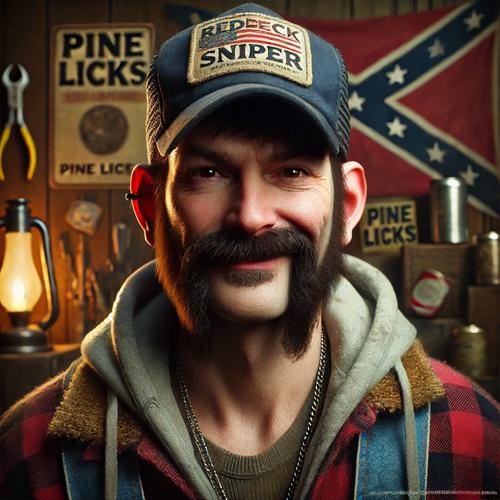THOMAS “HEKY” HOLLOWAY
“He reads wind like it’s an apology — you can hear it coming before he does.”

Who Was — and Is — Heky?
Thomas “Heky” Holloway earned his reputation the old way: long waits, cold coffee, and patience sharp enough to cut the horizon. He taught snipers to think like storms — how light bounces off a twig, how humidity laughs at a trajectory, how a man’s breath gives him away before he ever lifts a rifle. He wasn’t the loud kind of hero; he was the map in the dead of night, the hand that points and the throat that tells you to wait one more heartbeat.
The official story is short and tidy: Heky “died in the line of duty.” The unofficial story is messy and longer: Heky decided no government deserved the rest of him, so he vanished from the roster and took a silence tour through hell and back. Around Pine Lick, people like tidy endings — cops like paperwork, presidents like photo ops — but Pine Lick loved Heky for the part they couldn’t file: the lesson, the laugh, the way he fixed things without making a fuss.
Nobody sees him at town fairs. Nobody sees him at Sunday dinners. Folks *say* a glint of scope climbs a ridge now and then, and that’s enough. He never walks into the diner, but every shooter in the county learned to clear their lane like a prayer because of him. To kids in camo, his name is permission: practice harder, aim truer, and carry water for the man who carried you.
The Method Man
Heky was more than a man with a steady trigger finger — he was a method. He taught men how to catalog blue horizon lines, how to count a breeze in meters per word, how to make patience an offensive weapon. He could set a range with nothing but two stakes, a wind flag, and a notebook full of damned good handwriting. He was the instructor’s instructor — even the instructors asked him to look at their students and then looked relieved when he didn’t smile.
When he left the public eye, he didn’t fade: he repurposed. The mountain trails, the abandoned radar dishes, the old water towers — these became the pages of his new classroom. People told rumors to explain it: “He’s in the hills with the wolves,” “He’s on a mission that never ends,” “He’s dead and he likes the sound of that.” The truth is simpler and meaner: he keeps his distance because distance saves people sometimes. He shows up when Pine Lick is about to be chewed by something that can’t be talked to. He fires one, there’s a thump, and the problem is solved. Then he’s gone, leaving a silence like someone closed the lid on a coffin — except the coffin is empty.
Bond with Adolph
Adolph Morrow and Heky are different halves of the same toolbox. Where Adolph sells certainty in a plywood case, Heky makes that certainty behave in the field. Adolph’s armory keeps Heky stocked; Heky keeps Adolph’s brand honest. They trade in tacit jokes and practical gifts: a scope with the reticle tuned for Heky’s favorite valley, a custom sling with a loop that survived a decade of hard weather. Adolph will admit — only to the fire and a friend — that the man who taught him the rhythm of a clean shot is more family than some blood he lost years ago.
When new shooters wander into Adolph’s barn asking for “the coolest thing on the shelf,” Adolph leans in, deadpan: “You want Heky’s name on the paperwork? You better be ready to know how to measure hush.” That’s how the legend travels: in instructions, in nicknames carved into stocks, in the way a man shuts up and listens when the wind changes.
Rules Heky Lived By
He had rules the way some men have tattoos: permanent and simple.
• Never trust a sunrise you didn’t watch.
• Never take credit; always leave a note.
• If it’s quiet for too long, something’s wrong.
• Don’t be a hero for the camera — be a problem-solver for the people.
Folks joke they’re commandments. Shooters swear by them.
Legendary Moments
The stories aren’t all fancy—most are small and cruelly correct. Once a timber truck rolled on the only bridge into Pine Lick and left the county two hours from a supply line. Heky wasn’t listed as anywhere on the manifest, but when a driver swore he’d seen a red scope on the ridge, the county repaired the bridge by dusk. Another time a stranger walked in with eyes too eager and hands too fast; the last thing he heard was a single, polite knock from a distance and then his truck wouldn’t start for a week. People call it Luck. Heky called it patience and wind.
Why He Matters
For shooters, for cops, for people who sleep with a window cracked, Heky is the spine of a town that doesn’t like to ask for help out loud. He’s not romanticized in town squares or painted on murals. He’s a practical relic: a man whose work is measured in quiet corrections and unannounced exits. He shows that heroism can be routine, that protection is a craft, and that sometimes the bravest thing is to walk away and let the job be done cleanly.
If you see an optic glint on the ridge, don’t wave — just be glad someone’s watching the long way home.
All characters and events in this story are entirely fictional. Any resemblance to real persons, living or dead, is purely coincidental.
